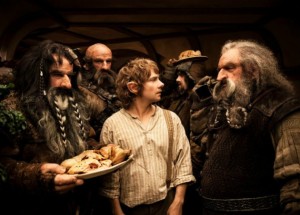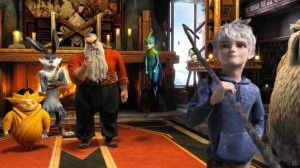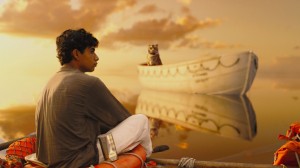Cirque du Soleil: Worlds Away
Posted on December 20, 2012 at 6:00 pm
Her curiosity overcoming her shyness, a girl with big eyes and a gamine haircut (Erica Linz) walks through the gate for the “Circus Marvelous.” She sees “The Aerialist” (Igor Zaripov), first smiling a welcome as he helps install the tent, then on a flier given to her by a clown, and then high above, performing with breathtaking ease and grace. Suddenly he falls, hitting the sandy ground below, which collapses beneath him like quicksand. The girl goes after him through an enchanted world of fantasy, splendor and feats of artistry, acrobatics, dance, music, and very firm, lithe bodies jumping, swirling, twisting, and bending, all in very tight costumes. Plus there is an adorable tricycle powered only by a pair of small yellow galoshes, and a man on fire reading a newspaper. He is not at all flustered when the flames creep up his body and onto his hat. The fire is almost a dance partner.
Cirque du Soleil is an international phenomenon with shows on every continent but Antarctica. Its founding principle is the immediacy and drama of live performance, the exact opposite of a movie. Anything that can be imagined can be put on film; its very appearance of truth makes us marvel at the technology for fooling us so effectively. We value Cirque for its old-school reality. When we sit in the tent, we see performances in real time, with real peril, never to be seen exactly the same way again. Producer James Cameron (“Avatar”) and director Andrew Adamson (“Shrek”) understand that they cannot replicate that experience and instead give us the chance to marvel by taking us up close and inside the action with immersive 3D. The seamlessness and grace of the acrobatics adds to the dreamy quality. In real life, we expect a sense of exertion and anxiety to underscore the sense of risk. In the movie, the balletic movement adds to the fantasy that we are in a frictionless world unlimited by the laws of physics.
The girl and the aerialist wander, fall, fly, and are chased through dreamlike — and occasionally nightmarish — scenes from seven of Cirque du Soleil’s Las Vegas shows: O, KÀ, Mystère, Viva ELVIS, CHRIS ANGEL Believe, Zumanity, and in one of the film’s highlights, the Beatles tribute show, LOVE. An almost mythic inclusion of the four classical elements: fire, water, earth, and air, provide the settings for movement that flows seamlessly between dance, athletics, and stunts that do more than defy the laws of gravity; they transcend them. In one stunning sequence, an enormous board studded with pins is tilted, distorting our perspective so that the performers swing as though they are weightless.
The costumes and make-up are dazzling, witty, and wildly inventive. In one scene, a pair of girls are connected by a single Dr. Seuess-style hairdo. In another, humans shaped like crustaceans skitter across the stage. Many of the trippy visuals are accompanied by the kind of music they play in spas to relax people getting facials, but things pick up with an Elvis song and a medley of Beatles classics, including “Octopus’ Garden,” “Lucy in the Sky with Diamonds,” “For the Benefit of Mr. Kite,” that unmistakeable first chord from “Hard Day’s Night,” and a resounding “All You Need is Love.”
Zaripov has a striking purity when he performs. It is beyond ease; it is serenity. There is no sign of stress or exertion, even when he seems to be holding himself parallel to the ground with just one hand on a rope. He juggles a giant cube as though he is balancing a prima ballerina. And when Linz finally catches up, their exquisite aerial ballet is one of the most eloquently romantic moments on screen this year.
Parents should know that there are some mildly scary moments including a snake and a kidnapping.
Family discussion: How is Cirque du Soleil different from traditional circuses? Which of the settings was your favorite and why?
If you like this, try: See Cirque du Soleil in person or watch the dance videos by LXD online




